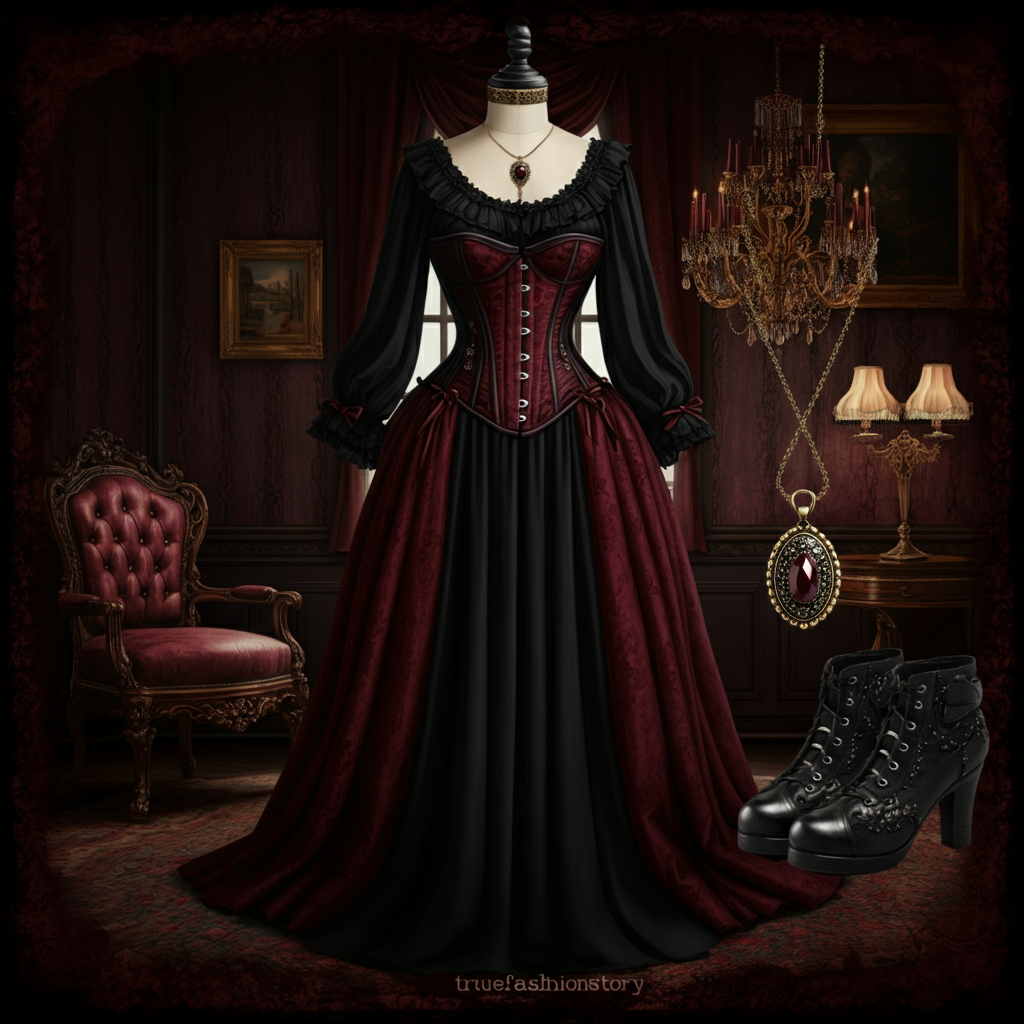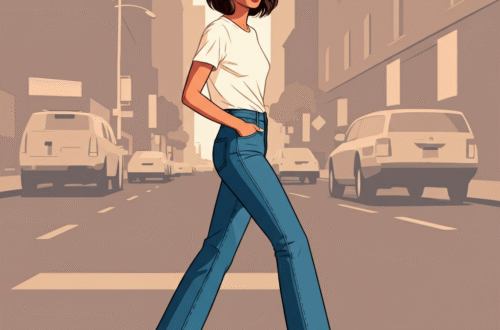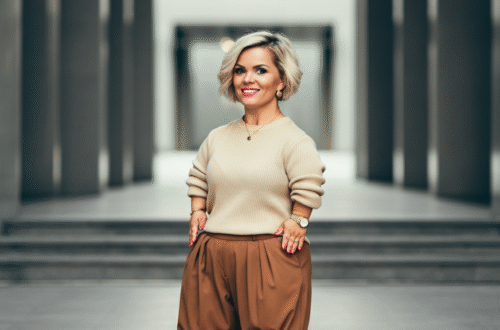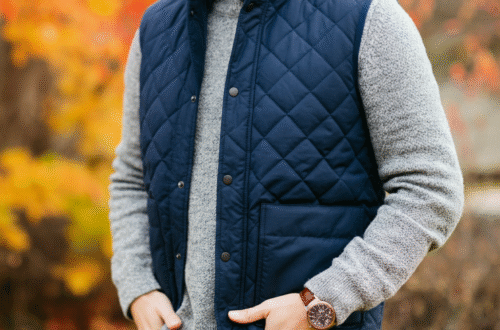Victorian gothic fashion represents one of fashion history’s most captivating movements, blending the elegance of the Victorian era with mysterious dark aesthetics. This distinctive style emerged during the 19th century and continues to influence modern fashion today. Whether you’re drawn to the dramatic silhouettes, rich fabrics, or symbolic accessories, victorian gothic fashion offers a unique way to express individuality through clothing.
The allure of this fashion style lies in its perfect balance between sophistication and rebellion. Victorian gothic fashion takes the refined elements of traditional Victorian dress and transforms them with darker colors, dramatic details, and mysterious undertones. From flowing black gowns to intricate corsetry, this style speaks to those who appreciate both historical elegance and alternative expression.
Understanding victorian gothic fashion requires exploring its rich history, key elements, and modern interpretations. This comprehensive guide will walk you through everything you need to know about this fascinating fashion movement, helping you appreciate its cultural significance and perhaps inspire your own wardrobe choices.
The Origins and History of Victorian Gothic Fashion
Victorian gothic fashion emerged during the Victorian era (1837-1901), drawing inspiration from Gothic Revival architecture and literature. The style developed as a response to the strict social conventions of the time, offering a way to express darker emotions and romantic ideals through clothing.
The Gothic Revival movement influenced all aspects of Victorian culture, from art and architecture to literature and fashion. Writers like Edgar Allan Poe and Gothic novels created an atmosphere of mystery and romance that naturally translated into clothing styles. Women began incorporating darker colors, dramatic silhouettes, and symbolic elements into their wardrobes.
This fashion movement wasn’t just about aesthetics – it represented a cultural shift. Victorian gothic fashion allowed people to explore themes of mortality, romance, and mystery within the confines of respectable society. The style provided an outlet for expressing emotions and ideas that weren’t always welcome in conventional Victorian society.
The influence of mourning dress also played a crucial role in shaping victorian gothic fashion. The elaborate mourning customs of the Victorian era, with their specific dress codes and extended periods of wearing black, created a foundation for the gothic aesthetic. These practices normalized dark, dramatic clothing and established many of the style elements we associate with victorian gothic fashion today.
Key Elements of Victorian Gothic Fashion
Silhouettes and Shapes
Victorian gothic fashion is characterized by specific silhouettes that emphasize both elegance and drama. The most iconic element is the corseted waist, creating an hourglass figure that was considered the ideal feminine shape. Long, flowing skirts with multiple layers added volume and movement, while high necklines maintained Victorian modesty standards.
Sleeves played a crucial role in victorian gothic fashion, often featuring dramatic puffed shoulders, tight-fitting arms, or flowing bell shapes. These sleeve variations added visual interest and created a sense of theatrical drama that defined the style. The overall silhouette aimed to create a statuesque, otherworldly appearance.
Men’s victorian gothic fashion featured tailored coats with dramatic collars, fitted trousers, and ornate waistcoats. The masculine silhouette emphasized a lean, aristocratic appearance with attention to detail in every garment piece. Capes and long coats added an element of mystery and grandeur to the male gothic wardrobe.
Color Palettes and Fabrics
The color palette of victorian gothic fashion centers around deep, rich tones that evoke mystery and elegance. Black remains the quintessential gothic color, but the palette extends to include:
- Deep burgundy and wine red
- Forest and emerald greens
- Rich purple and violet
- Midnight blue and navy
- Charcoal gray and silver
Fabric choices were equally important in creating the desired aesthetic. Velvet, silk, and brocade were preferred materials, offering both luxury and the right visual weight. These fabrics caught light beautifully, creating depth and richness that enhanced the dramatic silhouettes. Lace was extensively used for trim and detail work, adding delicate contrast to the bold overall designs.
The texture contrast was essential in victorian gothic fashion. Smooth silk might be paired with rough wool, or soft velvet combined with structured cotton. This interplay of textures created visual and tactile interest that made each garment unique and engaging.
Women’s Victorian Gothic Fashion Elements
Dresses and Gowns
Victorian gothic dresses served as the centerpiece of women’s gothic wardrobes. These garments typically featured fitted bodices with corseted waists, creating the desired hourglass silhouette. The skirts were full and flowing, often requiring multiple petticoats or bustles to achieve the proper shape and volume.
High necklines were common, often featuring intricate lace or embroidered details. Some dresses incorporated mock turtlenecks or standing collars, adding to the formal, mysterious appearance. Long sleeves were standard, though evening wear might feature off-shoulder designs or dramatic sleeve openings.
The length of victorian gothic dresses varied depending on the occasion and specific time period. Day dresses typically reached the floor, while evening gowns might feature trains or elaborate hemline details. The overall goal was to create a statuesque, elegant appearance that commanded attention and respect.
According to fashion historians at truefashionstory.com, the most authentic victorian gothic dresses featured multiple layers, intricate construction techniques, and attention to detail that modern fashion rarely matches. These garments were works of art, requiring skilled seamstresses and considerable time to create.
Corsets and Undergarments
Corsets formed the foundation of victorian gothic fashion for women, shaping the torso to achieve the idealized silhouette. Gothic corsets often featured more dramatic elements than their conventional counterparts, including:
- Steel boning for extreme waist reduction
- Elaborate lacing systems in contrasting colors
- Decorative elements like buckles, chains, or embroidered details
- Extended length to emphasize the torso
The goal wasn’t just waist reduction but creating a specific posture and bearing that embodied gothic elegance. Properly fitted corsets forced wearers to maintain an upright, statuesque posture that became synonymous with victorian gothic fashion.
Bustle pads and cage crinolines were essential for achieving the proper skirt silhouette. These undergarments created the volume and shape that made victorian gothic dresses so visually striking. The engineering required to support these massive skirts was considerable, involving multiple layers of structured undergarments.
Men’s Victorian Gothic Fashion Components
Coats and Jackets
Men’s victorian gothic fashion centered around dramatic outerwear that conveyed both sophistication and mystery. Frock coats were particularly popular, featuring fitted torsos, flared skirts, and ornate button details. These coats often reached mid-thigh or knee length, creating a distinguished silhouette.
Tailcoats represented the height of formal victorian gothic fashion for men. These garments featured cut-away fronts and long tails in back, creating a dramatic outline that was both elegant and imposing. The fitted construction emphasized the male form while maintaining appropriate coverage.
Cape coats added an element of theatrical drama to men’s victorian gothic fashion. These garments featured attached capes or separate cape accessories that created flowing lines and mysterious silhouettes. The combination of structured tailoring with flowing fabric elements embodied the gothic aesthetic perfectly.
Accessories and Details
Victorian gothic fashion for men relied heavily on accessories to complete the overall aesthetic. Top hats were essential, often featuring decorative bands, feathers, or other ornamental elements. Gloves were worn for both practical and aesthetic purposes, usually in black leather or fine fabric.
Pocket watches became symbolic accessories in victorian gothic fashion, representing the passage of time and mortality themes common in gothic culture. These timepieces were often ornate, featuring engraved cases and elaborate chain arrangements that served both functional and decorative purposes.
Walking sticks or canes completed the gentleman’s gothic ensemble, often featuring carved heads, metal decorations, or symbolic motifs. These accessories served practical purposes while adding another layer of visual interest to the overall outfit.
Victorian Gothic Fashion Accessories and Jewelry
Symbolic Jewelry Pieces
Jewelry played a crucial role in victorian gothic fashion, serving both decorative and symbolic purposes. Gothic jewelry often incorporated symbols of mortality, spirituality, and romance, creating pieces that were conversation starters and personal statements.
Popular motifs included:
- Skulls and crossbones representing memento mori
- Crosses and religious symbols
- Ravens, bats, and other dark creatures
- Roses and thorns symbolizing beauty and pain
- Keys representing mystery and secrets
These symbolic elements weren’t chosen randomly but reflected the philosophical and emotional themes that drove the gothic movement. Wearing such jewelry was a way to express one’s appreciation for deeper meanings and alternative perspectives on life and beauty.
Hair Accessories and Styling
Victorian gothic hairstyles required specific accessories to achieve the desired dramatic effect. Hair combs made from tortoiseshell, silver, or carved bone were essential tools for creating elaborate updos and securing decorative elements.
Ribbons and bands in dark colors helped accent gothic hairstyles, often incorporating lace, velvet, or satin materials. These accessories weren’t merely functional but served as integral design elements that tied the hairstyle to the overall outfit aesthetic.
Hair jewelry, including ornate pins, clips, and even small chains, added metallic elements that caught light and created visual interest. The goal was to create hairstyles that appeared both elegant and slightly mysterious, fitting the overall gothic aesthetic.
Modern Victorian Gothic Fashion Revival
Contemporary Interpretations
Modern victorian gothic fashion has evolved considerably from its 19th-century origins while maintaining the core aesthetic principles. Contemporary designers blend historical elements with modern construction techniques and lifestyle requirements, creating pieces that honor the past while serving present-day needs.
Today’s victorian gothic fashion often features:
- Modern synthetic materials that mimic historical fabrics
- Simplified construction for easier wear and care
- Adapted silhouettes that work with contemporary body ideals
- Integration with modern accessories and technology
The revival has been driven partly by popular culture, including movies, television shows, and music that celebrate gothic aesthetics. This mainstream exposure has made victorian gothic fashion more accessible while maintaining its alternative edge.
Subcultures and Communities
The modern victorian gothic fashion scene encompasses several distinct subcultures, each interpreting the style differently. Steampunk fashion incorporates victorian gothic elements with industrial and mechanical motifs, creating a unique fusion aesthetic.
Romantic goth communities focus on the softer, more feminine aspects of victorian gothic fashion, emphasizing lace, florals, and flowing fabrics. These interpretations often feature lighter color palettes while maintaining the essential structural elements of the historical style.
Corporate goth represents another evolution, adapting victorian gothic fashion elements for professional environments. This interpretation focuses on subtle details, refined silhouettes, and sophisticated color choices that honor the gothic aesthetic while remaining workplace appropriate.
Victorian Gothic Fashion vs. Other Gothic Styles
|
Style Element |
Victorian Gothic |
Modern Goth |
Romantic Goth |
Industrial Goth |
|---|---|---|---|---|
|
Silhouette |
Structured, corseted |
Varied, often loose |
Flowing, ethereal |
Angular, geometric |
|
Colors |
Black, burgundy, deep jewel tones |
Primarily black |
Pastels with black |
Black with metallics |
|
Fabrics |
Velvet, silk, brocade |
Cotton, synthetic blends |
Chiffon, lace, silk |
Leather, PVC, metal |
|
Accessories |
Ornate jewelry, gloves, hats |
Minimal, symbolic |
Flowers, ribbons, delicate pieces |
Chains, studs, industrial elements |
|
Historical Period |
19th century Victorian era |
1980s-present |
1990s-present |
1990s-present |
Shopping for Victorian Gothic Fashion
Where to Find Authentic Pieces
Finding authentic victorian gothic fashion requires knowledge of reliable sources and quality indicators. Vintage shops and estate sales occasionally offer genuine Victorian pieces, though these are increasingly rare and expensive. Reproduction specialists create high-quality replicas using historical patterns and construction techniques.
Online marketplaces have expanded access to victorian gothic fashion, but buyers must be cautious about quality and authenticity. Reputable sellers provide detailed measurements, fabric information, and construction details that help ensure satisfaction with purchases.
Custom seamstresses and tailors offer another avenue for acquiring victorian gothic fashion, often providing the best fit and quality. These professionals can create pieces tailored to individual measurements and preferences while maintaining historical accuracy.
Budget Considerations
Authentic victorian gothic fashion represents a significant investment, with genuine antique pieces commanding premium prices. Quality reproductions offer a more accessible entry point while still providing the desired aesthetic and construction quality.
Budget-conscious enthusiasts can build their victorian gothic wardrobes gradually, investing in key pieces like corsets or coats first, then adding accessories and supporting garments over time. This approach allows for quality purchases without overwhelming financial commitment.
DIY approaches can also make victorian gothic fashion more affordable, though they require significant time investment and sewing skills. Many patterns are available for creating historically accurate pieces, and online communities provide support and guidance for beginners.
Caring for Victorian Gothic Fashion Garments
Maintenance and Storage
Victorian gothic fashion garments require special care due to their construction methods and fabric choices. Velvet and silk need gentle handling, while corsets require specific storage methods to maintain their structure and boning integrity.
Professional cleaning is often necessary for elaborate victorian gothic pieces, particularly those with multiple fabric types or delicate trims. Home care should focus on proper storage, using acid-free tissue paper, cedar blocks, and climate-controlled environments when possible.
Regular inspection helps catch small problems before they become major repairs. Loose buttons, frayed seams, and worn areas should be addressed promptly to maintain the garment’s appearance and structural integrity.
Restoration and Repair
Restoring vintage victorian gothic fashion requires specialized skills and knowledge of historical construction techniques. Professional textile conservators offer the best results for valuable or historically significant pieces, though their services command premium prices.
Basic repairs like button replacement or minor seam work can often be handled by experienced seamstresses familiar with historical garments. The key is using appropriate materials and techniques that match the original construction methods.
Documentation of repairs and restorations helps maintain the garment’s provenance and value. Photographs, material samples, and detailed notes about work performed create valuable records for future care and potential resale.
Victorian Gothic Fashion in Popular Culture
Media Influence and Representation
Victorian gothic fashion has found new life through popular media, appearing in films, television shows, and music videos that celebrate its dramatic aesthetic. Period dramas often showcase authentic or carefully researched versions of the style, introducing new audiences to its appeal.
Tim Burton’s films have particularly influenced modern perceptions of victorian gothic fashion, blending historical accuracy with artistic interpretation. These representations often emphasize the more theatrical aspects of the style while maintaining its essential elegance and mystery.
Fashion magazines and blogs regularly feature victorian gothic fashion editorials, helping maintain its relevance in contemporary style conversations. These publications often provide styling tips and shopping guides that make the style more accessible to modern audiences.
Celebrity Adoption
Several celebrities have embraced victorian gothic fashion elements, bringing mainstream attention to the style. Musicians, in particular, have adopted gothic aesthetics as part of their artistic personas, influencing their fans’ fashion choices.
Red carpet appearances featuring victorian gothic fashion elements often generate significant media coverage and public interest. These high-profile showcases demonstrate the style’s versatility and enduring appeal across different contexts and occasions.
Social media influencers have also played a role in popularizing victorian gothic fashion, sharing outfit inspirations, shopping tips, and styling advice with their followers. This grassroots promotion has helped maintain the style’s relevance among younger demographics.
Key Takeaways
Understanding victorian gothic fashion requires appreciating its historical context, symbolic elements, and modern interpretations. This style represents more than clothing choices – it embodies a philosophical approach to beauty, mystery, and self-expression that continues to resonate with contemporary audiences.
The essential elements of victorian gothic fashion include structured silhouettes, rich fabrics, symbolic accessories, and dramatic color palettes. These components work together to create looks that are both historically informed and personally meaningful.
Modern practitioners of victorian gothic fashion can choose from various interpretation levels, from historically accurate reproductions to contemporary adaptations that honor the style’s spirit while serving modern lifestyle needs. The key is understanding the underlying principles that make the style distinctive and appealing.
Quality investment pieces form the foundation of any victorian gothic wardrobe, with accessories and details adding personality and individual expression. Building a collection gradually allows for thoughtful choices that create cohesive, authentic-looking ensembles.
Frequently Asked Questions
What makes Victorian gothic fashion different from regular Victorian fashion?
Victorian gothic fashion takes traditional Victorian elements and emphasizes darker colors, more dramatic silhouettes, and symbolic accessories. While regular Victorian fashion focused on propriety and social status, gothic variations explored themes of mystery, romance, and mortality through clothing choices.
Can Victorian gothic fashion be worn in professional settings?
Yes, with careful styling. Modern professional interpretations focus on sophisticated silhouettes, quality fabrics, and subtle gothic details rather than dramatic theatrical elements. Key pieces like well-tailored black blazers, elegant accessories, and refined color choices can create workplace-appropriate gothic looks.
How expensive is authentic Victorian gothic fashion?
Authentic vintage pieces are quite expensive, often ranging from hundreds to thousands of dollars depending on condition and provenance. Quality reproductions offer more affordable options, typically costing $200-800 for major pieces like dresses or coats. Budget alternatives and DIY approaches can make the style more accessible.
What body types work best with Victorian gothic fashion?
Victorian gothic fashion can flatter various body types through proper fit and styling. The corseted waist creates an hourglass silhouette regardless of natural shape, while flowing skirts and structured jackets can balance proportions. The key is finding well-fitted garments and understanding how different elements affect your specific figure.
Is Victorian gothic fashion comfortable to wear?
Comfort levels vary significantly depending on the specific garments and construction quality. Well-fitted corsets can actually provide good back support, while properly designed bustles distribute weight effectively. Modern reproductions often incorporate comfort improvements while maintaining authentic appearance.
How do I start building a Victorian gothic wardrobe?
Begin with one or two key pieces like a well-fitted corset or quality coat, then gradually add supporting garments and accessories. Research reputable sellers, understand sizing requirements, and consider your lifestyle needs. Building slowly allows for quality investments and ensures pieces work well together.
Conclusion
Victorian gothic fashion represents a fascinating intersection of historical elegance and alternative expression that continues to captivate fashion enthusiasts today. From its origins in 19th-century Gothic Revival culture to its modern interpretations across various subcultures, this style demonstrates the enduring power of clothing to convey meaning, emotion, and individual identity.
The key to successfully embracing victorian gothic fashion lies in understanding its fundamental principles while adapting them to contemporary life. Whether you choose authentic vintage pieces, quality reproductions, or modern interpretations, the goal remains the same: creating looks that honor the style’s rich heritage while serving your personal aesthetic and practical needs.
As fashion continues to evolve, victorian gothic fashion’s influence can be seen in everything from haute couture collections to street style interpretations. Its emphasis on craftsmanship, symbolic meaning, and dramatic beauty offers valuable lessons for anyone interested in fashion as both art form and personal expression.
The investment in victorian gothic fashion – whether financial, temporal, or creative – rewards enthusiasts with garments and accessories that transcend trends and seasons. These pieces become part of personal style narratives that can last lifetimes, growing more meaningful and beautiful with age and careful stewardship.





